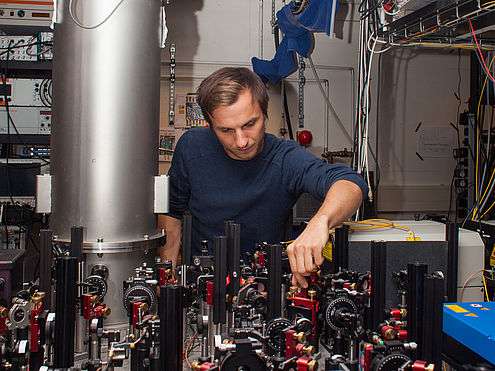Researchers prevent quantum errors from occurring by continuously watching a quantum system

A team of scientists led by Tim Taminiau of QuTech, the quantum institute of TU Delft and TNO, has now experimentally demonstrated that errors in quantum computations can be suppressed by repeated observations of quantum bits.
Quantum computers are based on qubits that, unlike classical bits, can not only take the values 0 or 1 but can also be 0 and 1 at the same time. Such quantum systems are naturally fragile: they constantly evolve in uncontrolled ways due to unwanted interactions with the environment, leading to errors in the computation. A team led by Tim Taminiau managed to suppress such errors through the so-called quantum Zeno effect.
By repeatedly observing quantum bits, encoded in spins in diamond, unwanted transformations of these qubits are suppressed. The presented work provides direct insight into the physics of measurements on quantum states and is relevant for quantum error correction and detection, which is crucial for a working quantum computer. The scientists have published their work on the 7th of October in Nature Communications.
Quantum superposition
The QuTech institute in Delft is working on the computer of the future: the quantum computer. This computer is based on the counter intuitive laws of quantum mechanics, allowing it to solve certain important problems that are far beyond the reach of the best classical computers. The building blocks of the quantum computer, qubits, can not only take the values '0' or '1', but also '0' and '1' at the same time, which we call a quantum superposition.
Zeno's paradox
The Greek philosopher Zeno of Elea stated in his 'arrow paradox' that a flying arrow is standing still when constantly observed. That is because, according to him, every time the arrow is observed at a single instance, it is not seen to move and therefore in rest. Thus, under constant observation, the flying arrow is constantly standing still and motion must be impossible.
In classical mechanics, such as for the flying arrow, this paradox has been solved by differential calculus, However, in quantum mechanics observations really do restrict the evolution of quantum systems: this is called the quantum Zeno effect. If an observable of a quantum state is measured, the system is projected into an eigenstate of this observable. For example, if a qubit in a superposition of '0' and '1' is observed, the qubit is projected into either '0' or '1' and will remain frozen in that state under repeated further observations.
Joint observables
While just freezing a quantum state by projecting a single qubit does not allow for computations, new opportunities arise when observing joint properties of multi-qubit systems. The projection of joint properties of qubits can be explained with the following analogy: consider grouping three-dimensional objects based on their two-dimensional projection. Shapes can still transform within a subgroup (for example between a cube and a cylinder), but unwanted changes (for example to a sphere) are suppressed by the constant observations of the 2D projection. Similarly, the projection of joint observables in multi-qubit systems generates quantum subspaces. In this way, unwanted evolution between different subspaces can be blocked, while the complex quantum states within one subspace allow for quantum computations.
Diamond
The QuTech scientists experimentally generated quantum Zeno subspaces in up to three nuclear spins in diamond. Joint observables on these nuclear spins are projected via a nearby electronic spin, generating protected quantum states in Zeno subspaces. The researchers show an enhancement in the time that quantum information is protected with increasing number of projections and derive a scaling law that is independent of the number of spins. The presented work allows for the investigation of the interplay of frequent observations and various noise environments. Furthermore, the projection of joint observables is the basis of most quantum error correction protocols, which are essential for useful quantum computations.
More information: N. Kalb et al. Experimental creation of quantum Zeno subspaces by repeated multi-spin projections in diamond, Nature Communications (2016). DOI: 10.1038/ncomms13111
Journal information: Nature Communications
Provided by Delft University of Technology





















